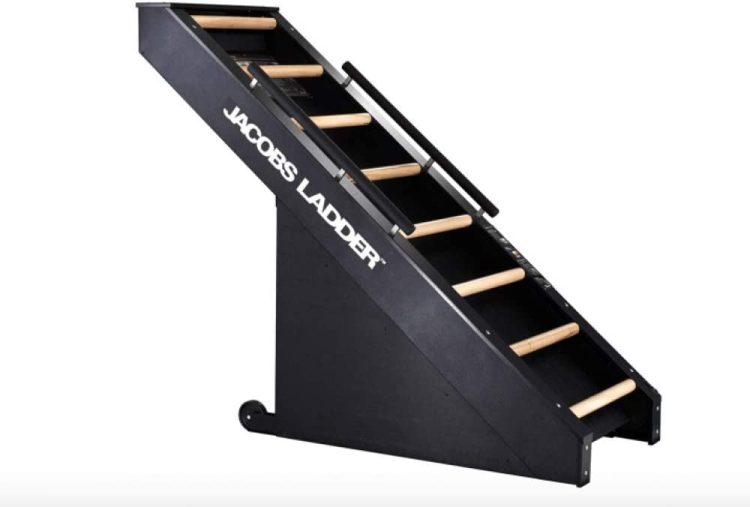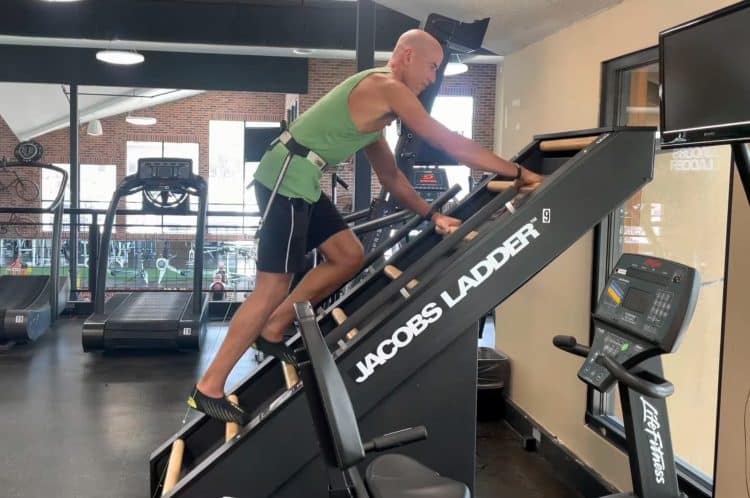Jacobs Ladder is a low-impact, high-intensity interval training cardio equipment. Elite athletes can use it for conditioning, and people dealing with injuries can use it for safe rehab work. Although Jacobs Ladder is a niche training machine, it is gaining popularity and making its way into several commercial and garage gyms.
Jacobs Ladder, named after the Biblical stairway to heaven, is a treadmill-style ladder climber with a 40-degree climbing angle, mimicking a ladder set up against a wall at that angle. Unlike the spin bike or Straimaster, the Jacobs Ladder machine requires you to use your arms and legs simultaneously, delivering a full-body workout.
While using Jacobs Ladder, you almost feel like Spider-Man climbing up a building. It isn’t long before, however, that your spidey sense kicks in, and you sense the impending muscle exhaustion and fatigue.
This article lays down the genesis of Jacobs Ladder, its target muscles, benefits, common mistakes, and how to use the machine to get the best bang for your buck. We have also included three workouts for different training goals.
What is Jacobs Ladder Exercise?

Jacobs Ladder is a self-powered ladder mill that offers a full-body workout without stressing your lower back, hips, and knees. This ladder mill features ladder-like rungs that allow you to climb in place. You set your own pace on the Jacobs Ladder, and it gives you real-time readings like the elapsed time, feet climbed, rate (feet per minute), calories burned, and heart rate on its digital display.
Steve Nichols, a former Western New York fitness champion, developed the Jacobs Ladder and started production in the early 1990s. Bob Palka took over the brand in the mid-2000s. The company, however, started gaining traction in 2009 after Jacobs Ladder was featured in the hit TV show The Biggest Loser. In an interview, Palka revealed that his business was $285 away from going bankrupting in 2007.
Level Up Your Fitness: Join our 💪 strong community in Fitness Volt Newsletter. Get daily inspiration, expert-backed workouts, nutrition tips, the latest in strength sports, and the support you need to reach your goals. Subscribe for free!
The company started with a single product in the 1990s. They now offer three Jacobs Ladder models:
- Ladder Mill
- Ladder Mill 2, which has a smaller footprint than the original model and steel tubes with polyurethane rungs instead of the solid maple rungs
- Jacobs Ladder X — their newest product
The Jacobs Ladder X is the company’s most successful product. It features the maple rungs that the users love and offers four different climbing positions, which help train different muscle groups at different intensity levels.
A 2016 study found that Jacobs Ladder burned more calories than the treadmill with minimal joint impact. The ladder mill users also displayed a lower rate of perceived exertion than the treadmill group, meaning they got better results without feeling exhausted. [1]
You could use the Jacobs Ladder in your standalone cardio regimen or include it in your high-intensity circuit training routine.
Muscles Worked During Jacobs Ladder
Jacobs Ladder works your core, glutes, quads, hamstrings, calves, shoulders, chest, triceps, and biceps. The Jacobs Ladder is a cardio machine. It is common, however, for strength athletes to end their ladder mill session with a sick lower body, arms, and shoulder pump.
Benefits of Jacobs Ladder
Below are the advantages of adding Jacobs Ladder to your training regimen:
Helps Burn Fat
Jacobs Ladder can improve your aerobic and anaerobic muscle and cardiovascular strength and endurance. Depending on your goals, you could use it in a low-intensity steady state or high-intensity interval training routine. It also spikes your metabolic rate, enabling you to burn calories hours after finishing your workout.
Build Coordination
Unless you are a climber, the Jacobs Ladder will be a new stimulus for you. No other machine mimics Jacobs Ladder’s movement pattern. Since you have to use all your limbs in this exercise, it helps build hand-eye coordination.
It’s not a machine where you can walk mindlessly for hours while checking your Instagram feed. You have to be careful with each step. On the other hand, Jacobs Ladder is a very safe machine. It slows down if you slip, allowing you to get off the ladder unscratched. Plus, the machine remains locked until you attach the belt to your waist.
Low-Impact
Unlike the treadmill, the Jacobs Ladder is a low-impact exercise that saves your lower body joints from overexertion. It makes this machine safe to use and lowers the risk of injury during high-intensity training. The ladder mill is also a great cardio equipment for people dealing with injuries.
Full Body Engagement
Although cardio machines like the elliptical and treadmill also engage your upper body, the stimulation you get on the Jacobs Ladder is unparalleled. It activates your upper body, lower body, hip abductors, and core. Since Jacobs Ladder engages your entire body, you’ll fatigue sooner than on other cardio machines.
Higher Calorie Burning
Jacobs Ladder engages multiple muscle groups simultaneously, resulting in higher calorie burning in a shorter period than other cardio machines.
Keeps Your Spine in a Neutral Position
The 40-degree angle of Jacobs Ladder mimics a bear crawl. It puts your spine in a neutral position, engages your upper and lower body and core, and destresses your lower back.
Fit For Your Home Gym
Since Jacobs Ladder is self-powered, you can place it in any corner of your home gym. Plus, it has a smaller blueprint than a treadmill, is relatively portable, and you can move it around until you find the perfect spot.
Simple To Use
As Jacobs Ladder is self-powered, you pace your workouts. Climbing faster will make the rungs go around more quickly, and slowing down will drop your pace. You wear a connected waist belt while using this machine, which makes the machine responds to your speed based on the tension on the connecting cable.
Staying on the upper end of the ladder will make the machine go faster, and climbing at the lower end will slow down the ladder mill. As you might have guessed, staying in the middle will keep the machine at a moderate speed. Plus, the machine is very responsive. It speeds up as soon as there is more tension on the cable.
Level Up Your Fitness: Join our 💪 strong community in Fitness Volt Newsletter. Get daily inspiration, expert-backed workouts, nutrition tips, the latest in strength sports, and the support you need to reach your goals. Subscribe for free!
How To Use Jacobs Ladder

Although Jacobs Ladder might look intimidating, it is relatively easy to use. Here is how to use the machine correctly:
1. Wear The Best
Strap on the belt before you get on the machine. The ladder mill assesses tension on the cable to adjust its speed. Unlike the treadmill, you cannot use Jacobs Ladder without harnessing the safety pin. The ladder will remain locked until you wear the belt. Adjust the strap so it’s neither too tight nor too loose. You must also adjust the belt for your height.
The waist belt also contains a heart rate monitor. Your heart rate, the time elapsed, total feet climbed, feet per minute, and calories burned appear in the console at the top of the ladder mill.
2. Start Climbing
You can climb the ladder after wearing the belt. As you climb faster, you will move toward the machine’s top half, making it go even more quickly. You’ll have to return to the machine’s center or bottom half to slow down.
Treadmills have a 3-5 second lag when you bump up the speed. You’ll experience instant speed-ups as you increase your climbing speed on the Jacobs Ladder. Plus, stopping climbing after a dash will make you stop dead in your track. This feature adds confidence to go all out during sprints.
Ensure that you maintain a neutral spine while using this machine. Rounding your back or overarching can put unnecessary stress on your lower back. Keep your head neutral to avoid spraining your neck. Use a hand-over-hand motion to burn the most calories.
3. Stop
You will find yourself at the bottom half of the machine as you slow down. The ladder mill will stop as soon as you halt climbing. You can hop off the machine when the rungs stop circulating. Take off the belt once you are off Jacobs Ladder.
Different Ways To Use Jacobs Ladder
There are seven ways to use the ladder mill:
- Assisted climbing with hands on the side rails
- Single-step climbing
- Double-step climbing by using every other rung
- Spider climb, similar to a Spider-Man push-up
- Sled push
- Left side steps while holding the rails
- Right side steps while holding the rails
Common Mistakes While Using Jacobs Ladder
Here are some of the most frequent ladder mill errors:
Using a Jumping Motion
Many people use a jumping motion to climb the ladder mill, increasing their odds of slipping or missing a step. Plant your hands and feet on the rungs with each step. Instead of jumping on the rungs, increase the intensity and pace using more pushing force.
Rounding Your Back
It’s common for beginners to round their backs as they increase their speed. Most begin the exercise with a neutral spine but fall prey to bad form as they start fatiguing. Slow down if you feel you’re compromising your form.
Sticking To The Side Railing
Many people hold onto the ladder mill side railing throughout the exercise. Doing this removes their upper bodies from the equation. You should use a hand-over-hand movement to make the most of this exercise. Reserve the side railing (or the other handles on the JLX) for breathers.
Jacobs Ladder Workout
You could use Jacobs Ladder in three ways:
1. For Warm-Ups or Cool Downs
You could incorporate Jacobs Ladder into your warm-up or cool-down regimen. Spend 5-10 minutes on the ladder mill at a low intensity. Maintain the same pace throughout the cardio session for best results.
2. In Circuits
You could include Jacobs Ladder into your HIIT cardio routine or CrossFit WOD. Here are a couple of circuit examples:
Circuit 1 (HIIT Cardio)
Perform each exercise for 60 seconds and rest for 10 seconds. Rest for a minute after completing the circuit. Repeat three times.
- Crunches
- Plank
- Jacobs Ladder (85-90% of maximum heart rate)
- Jumping Jacks
- Push-Up
- Burpee
Circuit 2 (CrossFit WOD)
Complete the workout as fast as possible:
- 50 burpees
- Jacobs Ladder: Climb 1,300 feet
- 100 push-ups
- Jacobs Ladder: Climb 1,300 feet
- 150 walking lunges
- Jacobs Ladder: Climb 1,300 feet
- 200 air squats
- Jacobs Ladder: Climb 1,300 feet
- 150 walking lunges
- Jacobs Ladder: Climb 1,300 feet
- 100 push-ups
- Jacobs Ladder: Climb 1,300 feet
- 50 burpees
3. Conventional Cardio Equipment
You could also use Jacobs Ladder in your conventional cardio training regimen. Here is a sample workout:
- Complete a 2-minute warm-up (70% of maximum heart rate)
- Climb for 15-20 minutes at a constant speed (Stay close to 80% of maximum heart rate)
- Cool down for 3 minutes at a slow speed
FAQs
Can people with back injuries use Jacobs Ladder?
It depends on the severity and nature of your back injury. If you are dealing with injuries, you should consult your doctor before exercising.
How long should a Jacobs Ladder workout last?
Since Jacobs Ladder is a full-body exercise, you should expect to spend 10-20 minutes on this machine. Going too fast can cause exhaustion and end your workout quickly. Using a hand-over-hand movement can take you to failure faster. You could have a time or feet per minute target while using Jacobs Ladder.
How much time do I need to master Jacobs Ladder?
Unlike the treadmill, Stairmaster, or elliptical, Jacobs Ladder requires hand-eye coordination, especially while using the hand-over-hand method. Beginners should take at least two 10-minute sessions on the Jacobs Ladder to develop muscle memory before increasing their training intensity.
Wrapping Up
Jacobs Ladder is an incredibly effective cardio machine that delivers a full-body workout. The ladder mill is a functional exercise that trains your core, glutes, quads, hamstrings, calves, shoulders, chest, triceps, and biceps.
Since Jacobs Ladder is uncommon, you should never miss an opportunity of using this machine. Use the three workouts and training tips in this article to ensure you make the most of the ladder mill. Best of luck!
References
- Allerton TD, Earnest CP, Johannsen NM. Metabolic and Mechanical Effects of Laddermill Graded Exercise Testing. J Strength Cond Res. 2018 Jan;32(1):195-200. doi: 10.1519/JSC.0000000000001802. PMID: 28135225; PMCID: PMC5831369.









